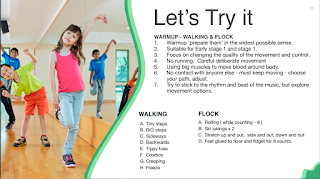BLOG POST #2 - What Value do Students get from Participating in Dance?
Responding Statement
Dance is the skill and knowledge of exploring movement to express and communicate ideas, emotions, and/or traditions. Student participation of the 'social language', that is dance, supports the overall development of the child. Facilitating dance in a safe and trusting classroom environment allows students to grow with confidence as they explore their awareness of body movement. Dance and movement in the classroom develop student flexibility, not only restricted to the physical and core strength of the individual but inclusive of the classroom culture, as we endeavor into flexible learning spaces to enhance student learning with movement and differentiation. Student expression is valued, as dance facilitates an outlet for students to communicate their unconscious feelings and troubles. The action of movement encourages students to exercise, to maintain or refine physical fitness or burn off excess energy, hyperactivity, in order to focus or concentrate on learning tasks. Exploring and choreographing collaboratively, students exercise socialising capabilities as they learn to 'play nice', 'work with' and 'listen to' peers. The added value of dance in the primary classroom is the ability and flexibility for teachers to plan applied or transferred learning opportunities, integrating dance with other key learning area's [KLA's] or addressing school values and strengthening general capabilities.
Learning in Dance
Dance is movement and movement is a form of communication.
Using proprioceptors, primarily in our feet, bodily movement can be maintained and controlled through balance, securing a sense of safety and awareness of the body's ability to move and express.
Broadening my skills and knowledge of dance, key terminology and language were introduced. Exploring the terms: non-locomotor movement, where the central weight of the body remains stationary. An example of a non-locomotor movement is clapping or the YMCA (Figure 2). On the other hand, locomotor movement entails an action when weight is carried or traveled. An example of locomotor movement includes slide stepping, jumping or the Nutbush (Figure 3). To further enhance an understanding of locomotor movement, terminology of movement levels and weight were explored, identifying the levels of action as high, mid, low and floor to indicate the movements' height from the floor. Where weight, described as heavy, medium or light, establishes body awareness in expressing or performing the intended energy or emotion.
Figure 2: The YMCA dance is a non-locomotor movement (YMCA of DeKalb County Inc., 2015)
Figure 3: The Nutbush dance is a locomotor movement (Camarri, 2015)
Exploring the importance of a warm-up was introduced. Loosening the joints, stretching and increasing the blood flow to muscles, prepares the body for the physical movement of dance. This weeks warm-up strategy was 'Walking and Flock', as seen in Figure 4.
Figure 4: Walking and Flock warm-up steps (Page, 2019)
Making in Dance
Adapting and applying the general capabilities into dance, literacy capabilities are targeted in this activity, aimed at infants students, kindergarten to year 2. In exploring literacy through movement, students are asked to express the letters of their name as a motif or sequence of a dance. Figure 5 is an example of the activity, expressing 'AMBER'.
Figure 5: My expression of the letters of my name, AMBER.
This activity can be further adapted and structured to support student confidence and creativity with the use of a 'movement alphabet' where students can perform their interpretation of an action. For example, A= jump, M= march, B= run, E= creep, R= explode, as demonstrated in Figure 6.
Figure 6: My Movement Alphabet
Content descriptors these activities demonstrate:
- ACADAM003 - Present dance that communicates ideas to an audience, including dance used by cultural groups in the community.
- ACADAM002 - Use fundamental movement skills to develop technical skills when practising dance sequences.
Responding in Dance
Peer feedback, reflection, and assessment are key components for self-reflection, revision and adapting learning within dance. Peer assessment and response of performance are also an opportunity for students to strengthen and broaden their dance knowledge, familiarising themselves with the vocabulary and terminology of dance.
For this activity, a students' artwork is given as stimulus, where students are to choreograph a motif or sequence of 5-7 movements to create a dance that interprets the artwork as seen in Figure 7. Figure 8 is my interpretation of the students' artwork.
Figure 7: Activity stimulus (FirstPalette.com, 2008-2019)
Figure 8: My interpretation from the activity stimulus
To appreciate the dance, students are given a 'peer assessment form' (Figure 9). Students describe observations, concerns or wishes for the dance, any suggestions for improvement and ask questions to clarify what they saw. Students are encouraged to explore and compare their points of view or interpretations and use dance terminology in their responses. A suggestion in exposing students to dance terms could be having a dance vocabulary wall or poster in the classroom.
Figure 9: Peer Assessment Form (Page, T., 2019)
References
ACARA. (2019).
Retrieved from Australian Curriculum:
https://www.australiancurriculum.edu.au/
Camarri, S.
(2015). Horsham Town Hall fundraising committee's Nutbush attempt launches. Retrieved from The Wimmera Mail-Times:
https://www.mailtimes.com.au/story/3264899/world-record-attempts-dont-come-much-nuttier-than-this-video-gallery/
FirstPalette.com.
(2008-2019). Sponge Painting. Retrieved from First Palette:
https://www.firstpalette.com/craft/sponge-painting.html
Page, (2019). How do I develop a passion for teaching dance? Creative Arts 2: Dance Session 2 - Week 3. EDUC24112 Curriculum Studies: Teaching Creative Arts II, Avondale College of Higher Education.
Page, T., (2019). Dance Primary Creative Arts booklet. EDUC24112 Curriculum Studies: Teaching Creative Arts II, Avondale College of Higher Education.
Page, (2019). How do I develop a passion for teaching dance? Creative Arts 2: Dance Session 2 - Week 3. EDUC24112 Curriculum Studies: Teaching Creative Arts II, Avondale College of Higher Education.
Page, T., (2019). Dance Primary Creative Arts booklet. EDUC24112 Curriculum Studies: Teaching Creative Arts II, Avondale College of Higher Education.
YMCA of DeKalb
County Inc. (2015). Donors. Retrieved from The YMCA of DeKalb County:
http://www.ymcadekalb.org/donors-and-donation-information.htm







Comments
Post a Comment